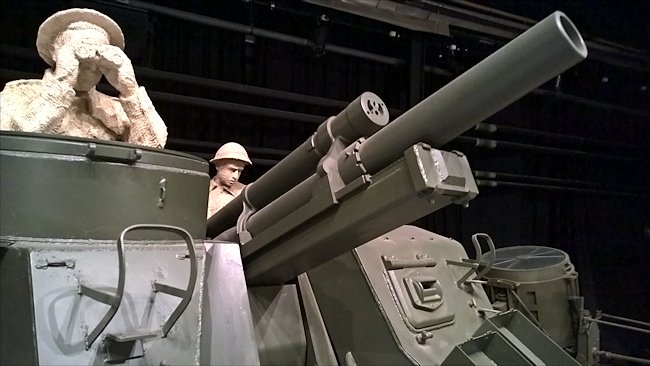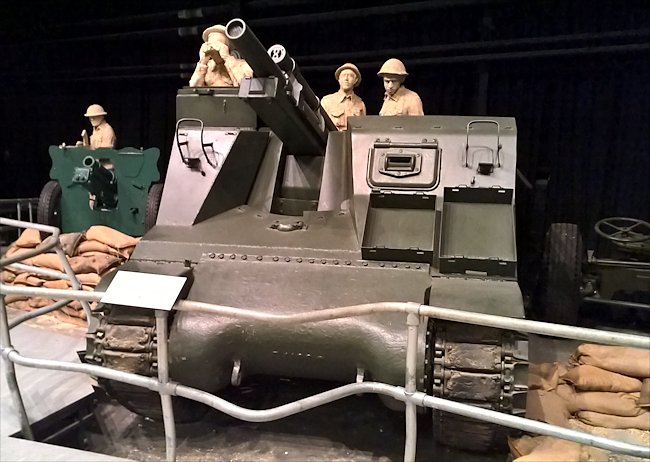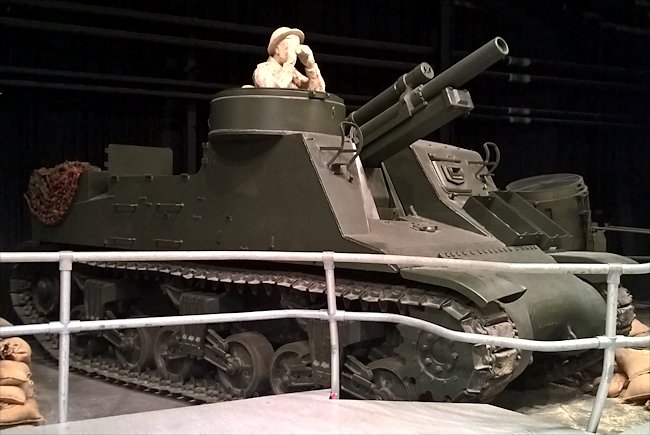M7 Priest 105mm Howitzer
This preserved WW2 M7 Priest Self Propelled Artillery Gun was armed with a 105 mm Howitzer. It can be seen at the Royal Artillery Museum Firepower in Woolwich, London

Restored WW2 M7 Priest 105mm self-propelled artillery howitzer at the RA Museum Firepower in Woolwich, London.
Although the Self Propelled Regiment was to some extent a specialized form of artillery, primarily suited for the close support of armour, it generally agreed that It was also capable of carrying out the normal tasks of horse or field artillery. In this capacity it had several advantages. It could move out of, but not into, action and change position quicker than towed artillery. Its greater cross-country mobility gave it a better choice of positions in difficult and road less country.
Its armour enabled it to be pinned to a position when under small arms and mortar fire. Its armour and heavy machine-gun combined made it less dependent on an infantry escort. In the early days of World War Two the Royal Artillery had the problem of developing the right SPG. The hastily improvised high profile 25pdr Bishop SPG had several serious disadvantages and in the absence of any suitable British substitute the British Army introduced the American 105-mrn M7.
With its ability to fire a 35-1b. shell to a range of 10,500 and internal gun traverse of about 40 degrees instead of 8 degrees, the Priest was definitely an improvement on the Bishop. Its greater speed enabled it to keep up with advancing tanks.

M7 Priest 105mm howitzer gun had a greater travers that the 25pdr Bishop SPG it replaced .
The WW2 American manufactured Priest SPG was officially known as a 105 mm Howitzer Motor Carriage M7. An armoured track-laying vehicle powered by a 400 hp nine cylinder modified radial aircraft petrol engine. Armed with a 105 mm M2 howitzer which is mounted to the right of the driver in front of the crew compartment. Other armament includes a calibre 0.50 Anti-Aircraft machine gun and a calibre .45 Thompson sub-machine gun.
With the arrival of the Sherman tank in the north African Desert a new technique for an attack by armoured units had been developed. Instead of tanks and infantry going in behind a heavy artillery barrage or concentration, which took insufficient count of the hidden anti-tank gun and minefield location, the Sherman tanks used their 75 mm guns for mutual support, while the artillery registered likely anti-tank gun positions and stood ready to engage them when required.
It was envisaged that one SP regiment equipped with M7 Priests would be assigned to each armoured division. The German 88mm Anti-tank gun was the greatest threat to British and Commonwealth Armoured units but they were susceptible to coordinated high explosive HE fire from Artillery battalions.

The American built M7 105mm self-propelled artillery howitzer was given the nickname the 'Priest' by the British because of its commanders 'pulpit'.
The British Army felt that in general the Priest self-propelled artillery gun had fullfiled the hopes that had been aroused by its initial performance in the desert. Owing to its nondescript appearance and to the flashless propellant with which it was equipped, it could operate amid the dust and smoke of battle in places where the towed 25-pdr artillery guns would probably have got in trouble.
The Priest could therefore keep close up behind the armour here it was sometimes used as by single guns. Indeed it was recognised that the self-propelled regiment belonged really more to the armoured brigade than to the Royal Artillery.
Since the Winter battles of 1940-41 where the slow moving but heavily armoured Matilda tank was at the height of its success, the role of the tank underwent a complete change. The Germans and Italian forces now used a lot more minefields to destroy and slow down advancing tanks.
Tactics had changed. It was no longer possible for tanks in an assault to precede the infantry at tank speed. The arrival of more powerful German anti-tank guns meant that it was important for British artillery to knock out the machine gun strongpoints and gun positions to minimise the casualties as a way through the enemy defences was forged.
The Priest was required to keep up with the advance and take on new targets as they were spotted. It became popular because it could fire time fuses. This meant that shells fired from a Priest would air burst over an enemy 88 mm gun or machine gun post and shower the ground with jagged hot sharp metal killing the gun crews and damaging the weapons.
The first M7s produced were sent straight to Egypt and were used by the British Army at the battle of Alamein in October 1942. The US Ordnance Department classified the 105mm howitzer used in the M7 priest as the M2A1 howitzer and was standardised in March 1940. The engineers used a gun the 'Mount M4' to fix the gun to the M3 Lee/Grant tank chassis when they constructed the prototype for the Priest. The Mount M4 resembled the trail legs of a towed field carriage cut down and spread across the fighting compartment in order to distribute he recoil forces.
Eventually the British Army phased out their use of the Priest in favour of new Sexton SPG. It consisted of a 25-pdr gun on a Canadian Ram 2 tank chassis. It had a longer firing range over the priest and could carry more ammunition. In mobility the two SPGs were about equal. Another advantage of converting the British SP regiments to using the Sexton was that it elevated the problem of relying upon supplies of US ammunition and spare parts.
Some Priests were on landing craft during D-Day to provide covering fire with their 105 mm howitzer guns. Ten regiments of self-propelled artillery fired 1800 rounds in 30 minutes from landing craft during the run-in on D-Day according to the Royal Artillery official notes Volume II (para 1204 point b). They were fired from the sea they advanced towards the beaches. Priest were used in Burma up until the end of the war fighting the Japanese.
Although Priests were not manufactured with machine guns mounted in their armour, many war time photographs show a heavy machine gun retro fitted to the 'pulpit' of the M7 as anti-aircraft protection and for self defence.
Enemy Delaying Tactics in Italy
The Germans used the abundance of cover to good effect in Italy to slow down the Allied advance. Cover in the form of low stone walls, farm houses, orchards, crops and ditches were utilised to conceal self-propelled guns like the StuG III with half a dozen machine gun teams dug in around it.
They would lay in wait and hold fire until the lead Allied tanks had got within 80 - 100 yards. After knocking out the first two tanks and killing a number of supporting infantry soldiers they would make a rapid get away to their next ambush point before they were out flanked.
This is where the Priest gun crews earned their pay. They would fire over the top of the advancing allied units and their HE shells would capture the retreating enemy soldiers caught out in the open and also knock out he armoured vehicles as the roof was always thinly armoured.
The rate of fire was fixed at three rounds a minute because of the danger of premature firing of the shell from a too hot barrel. This rate was only to be exceeded in cases of extreme operational urgency. A sponge cloth and a bucket of water was kept by each gun so that the chamber and mushroom head of the vent axial could be cleared of any debris after each round. Gun crews were instructed to be careful in loading each shell into the breach of the gun so that the fuse was not struck against the breech ring to prevent premature firing and injury.
Where can I find other preserved M7 Priests?
- Bastogne Barracks, Belgium
- Firepower museum, Woolwich, England
- Rex and Rod Cadman Collection, Kent, England
- Grafenwöhr Training Area, Grafenwöhr, Germany
- Paul Visser Collection, Winkel, Netherlands, Holland
- Normandy Tank Museum, Catz, near Carentan, France
- Museum Le Grand Bunker, Ouistreham, France
- 68th African Artillery Regiment, Camp de La Valbonne, France
- Panzermuseum, Thun, Switzerland
- Museo della Motorizzazione Militare della Cecchignola, Roma
- Caserma "Babini" di Bellinzago Novarese, Italy
- Military Barracks, Banja Luka, Bosnia and Herzegovina
- Batey ha-Osef Museum, Tel Aviv, Israel
- Philippine Military Academy, Baguio City
- Armor Academy and military base, HuKou, Hsinchu, Taiwan
- Museo Historico del Ejercito, Buenos Aires, Argentina
- Vermont Military Museum, Colchester, VT, USA
- Freeport, PA, USA
- Fort Dix, NJ, USA
- Institute of Military Technology, Titusville, FL, USA
- Patton Museum of Cavalry and Armor, Fort Knox, KY, USA
- Eisenhower Park, Abilene, KS, USA
- Rocky Mountain Museum of Military History, Missoula, MT, USA
- Yuma Proving Ground, AZ, USA
- Oregon Military Museum, Clackamas, OR, USA
- U.S. Army Ordnance Museum, VA, USA
- Virginia Museum of Military Vehicles (VMMV) Nokesville, VA, USA
- Russell Military Museum, Russell, IL, USA
- Marysville, KS, USA
- Kansas Army National Guard Museum, Topeka, KS, USA
- US Army Artillery Museum, Fort Sill, OK, USA
- 4th Infantry Division Museum, Ft. Hood, TX, USA
- 1st Cavalery Division Museum, Fort Hood, TX USA
- Texas Military Forces Museum, Camp Mabry, TX, USA
- American Society of Military History, Tankland, South El Monte, CA, USA
- Source - Pierre-Oliver Buan - http://the.shadock.free.fr/Surviving_Panzers.html
WW2 Tank Books

